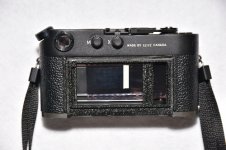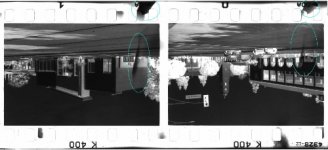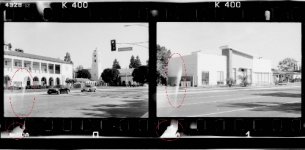EarlJam
Established
My M4-P has developed an odd light leak.
- It's intermittent, sometimes occurring on adjacent frames, sometimes not at all. For example, the first time it appeared, the leak affected three adjacent frames, 7 8 9, then nothing else on that roll. On the next roll I shot, frame 2 only. The next two rolls, no leaks. Next two rolls, on about 50% of the shots.
- When it does occur, it's always in the same location, but to varying degrees; sometimes faint, sometimes affecting much of the frame along a vertical axis.
- The leak in the image area is always accompanied by a distinctive pattern in the film rebate. Based on location, it appears that the leak is in the upper right of the film aperture, viewed from the back. As in the attached photos, I marked a strip of film and laid it in the camera as it would normally be exposed. The pattern in the rebate always occurs between perfs 1 and 2, counted from the right side, when the film is oriented as exposed.
I've run the common tests for this type of leak - covering the small RF window (tests the light baffle below the window); covering the back and hinge areas; and taping off all of the top, then selectively uncovering sections - but the leak occurs regardless. The shutter curtains appear OK, at least to my untrained eye. That the leak affects the rebate are seems to imply that the leak is coming from the back of the camera but, as noted, taping off the back didn't resolve the leak.
Any thoughts on other places to look, tests to run, or anyone with prior, similar experience who can comment on possible causes, are greatly appreciated. Thanks, all.
- It's intermittent, sometimes occurring on adjacent frames, sometimes not at all. For example, the first time it appeared, the leak affected three adjacent frames, 7 8 9, then nothing else on that roll. On the next roll I shot, frame 2 only. The next two rolls, no leaks. Next two rolls, on about 50% of the shots.
- When it does occur, it's always in the same location, but to varying degrees; sometimes faint, sometimes affecting much of the frame along a vertical axis.
- The leak in the image area is always accompanied by a distinctive pattern in the film rebate. Based on location, it appears that the leak is in the upper right of the film aperture, viewed from the back. As in the attached photos, I marked a strip of film and laid it in the camera as it would normally be exposed. The pattern in the rebate always occurs between perfs 1 and 2, counted from the right side, when the film is oriented as exposed.
I've run the common tests for this type of leak - covering the small RF window (tests the light baffle below the window); covering the back and hinge areas; and taping off all of the top, then selectively uncovering sections - but the leak occurs regardless. The shutter curtains appear OK, at least to my untrained eye. That the leak affects the rebate are seems to imply that the leak is coming from the back of the camera but, as noted, taping off the back didn't resolve the leak.
Any thoughts on other places to look, tests to run, or anyone with prior, similar experience who can comment on possible causes, are greatly appreciated. Thanks, all.




